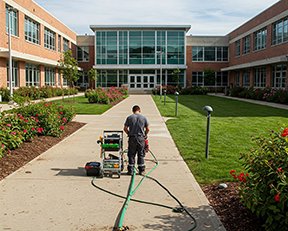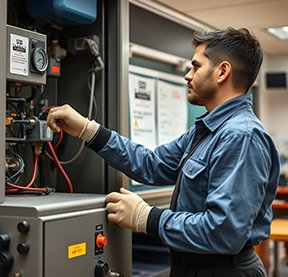Published: August 24, 2015 | Updated: September 18, 2025
Published: August 24, 2015 | Updated: September 18, 2025
Readying Your School: A Facility Manager's Blueprint for September Success
 August arrives, signaling the close of summer's carefree days and the imminent return of students to classrooms nationwide. For facility managers, this transition marks a critical period. The responsibility of preparing school facilities for the energetic influx of young learners looms large. It's more than just unlocking doors; it involves a multifaceted approach to ensure a safe, comfortable, and conducive learning environment. The task demands a facility manager's blueprint for September Success
August arrives, signaling the close of summer's carefree days and the imminent return of students to classrooms nationwide. For facility managers, this transition marks a critical period. The responsibility of preparing school facilities for the energetic influx of young learners looms large. It's more than just unlocking doors; it involves a multifaceted approach to ensure a safe, comfortable, and conducive learning environment. The task demands a facility manager's blueprint for September Success
Prioritizing Safety, Comfort, and Fiscal Responsibility
The preparation process touches upon several key areas that directly impact the well-being and educational experience of students and staff. Safety takes paramount importance. Facility managers must address potential hazards and implement measures to mitigate risks. Comfort also plays a significant role. A well-maintained and comfortable environment fosters better concentration and engagement. Simultaneously, these crucial considerations must align with often-constrained budgetary realities. Smart and efficient solutions become essential to balance needs with available resources. The challenge lies in achieving a high standard of preparedness without exceeding financial limitations.
Beyond the Buildings: Attending to the Grounds
The scope of facility management extends beyond the physical structures of school buildings. The surrounding grounds also demand careful attention. Common areas, where students congregate and interact, require maintenance and upkeep. Parking lots must be safe and accessible for both staff and visitors.
Furthermore, any outdoor or sporting grounds, such as baseball and football fields, necessitate proper preparation to ensure their usability and safety for athletic activities. For institutions with high schools and colleges, additional facilities like swimming pools and weight rooms add another layer of complexity to the pre-school year checklist. Each of these areas contributes to the overall functionality and appeal of the school environment.
Illuminating the Path to Efficiency and Safety
One strategic area where facility managers can achieve multiple benefits involves the school's lighting systems. Thoughtful upgrades and adjustments can lead to both cost savings and enhanced safety and comfort. The installation of timed lighting systems in restrooms, for instance, presents a practical method for reducing unnecessary energy consumption. Lights activate only when needed, preventing them from burning continuously in unoccupied spaces. This simple measure contributes directly to lowering utility bills and promoting energy conservation. Moreover, ensuring adequate illumination in stairwells and hallways plays a crucial role in minimizing the risk of accidents and falls. Well-lit pathways enhance visibility and create a safer environment for everyone navigating the school premises.
Addressing Glare in Technology-Rich Classrooms
The increasing integration of technology into the modern classroom introduces a new consideration for facility managers: glare control. As students increasingly rely on tablets and computer screens for learning, excessive glare from windows can significantly impede their ability to see the displays clearly. This visual interference can hinder their engagement with educational tools and ultimately affect their learning experience. Implementing solutions to mitigate glare, such as window coverings or strategically positioned workstations, demonstrates a proactive approach to creating an optimal learning environment in technology-enhanced classrooms.
Discover how streamlined maintenance processes can elevate production. Learn more.
Maintaining Safe and Healthy Walkways
Floor maintenance stands as another continuous responsibility for facility managers within a school setting. The condition of flooring directly impacts both the safety and the overall cleanliness of the school environment. Carpeting, a common flooring choice in many areas, requires diligent care to remain clean and free from allergens, mold, and mildew. This necessitates consistent cleaning schedules and the use of appropriate equipment to maintain healthy indoor air quality.
The same level of attention applies to other types of flooring as well. Tile, for example, can be susceptible to cracks or marks resulting from the movement of heavy furniture. Implementing preventative measures, such as the use of furniture casters or gliders, can significantly reduce the occurrence of scuffing and chipping, preserving the integrity of the flooring.
Strategic Furniture Choices for Easier Maintenance
To enhance the efficiency of cleaning and maintenance operations, facility managers should consider the characteristics of the school's furniture. Where feasible, opting for lightweight yet sturdy and stackable furniture offers significant advantages. This type of furniture allows maintenance and cleaning crews to move items around with ease, enabling them to clean thoroughly not just around but also underneath furniture. This accessibility contributes to a more hygienic environment and saves valuable time during cleaning routines.
Prioritizing Sanitation and Indoor Air Quality
Sanitation and air quality represent two exceptionally vital factors within school systems. Maintaining the health of both students and faculty is paramount. In environments where numerous individuals occupy confined spaces, the potential for the rapid spread of infections or illnesses increases considerably. This can lead to student absences and broader health concerns within the school community. To proactively prevent the transmission of germs, the installation of devices such as automated toilet-flushing systems and hands-free antibacterial soap dispensers can prove highly effective. Managers should establish and adhere to a rigorous daily cleaning schedule for all areas of the school. Particular attention should focus on kitchen areas, restrooms, and frequently touched surfaces like doorknobs and computer keyboards, as these often serve as breeding grounds for harmful bacteria and germs.
The Benefits of Proactive HVAC Maintenance
Routine maintenance of heating, ventilation, and air conditioning (HVAC) units offers significant benefits beyond simply regulating temperature. Properly maintained HVAC systems actively contribute to lowering the concentration of pollen and other allergens in the air circulating within the school buildings. This reduction in airborne irritants can significantly alleviate issues associated with asthma and other respiratory conditions among students and staff.
Moreover, consistent HVAC maintenance yields the added advantage of improved energy efficiency. Neglected heating and cooling systems can become significant energy consumers, leading to increased utility costs. A thorough inspection and servicing of the HVAC system before the start of the school year represents a prudent investment in both health and financial well-being.
 Leveraging Technology: How a CMMS Supports Back-to-School Preparations
Leveraging Technology: How a CMMS Supports Back-to-School Preparations
In today's dynamic environment, facility managers can significantly enhance their preparedness efforts by utilizing a Computerized Maintenance Management System (CMMS). A CMMS acts as a central hub for organizing, tracking, and managing maintenance activities, offering valuable tools to address the various aspects of back-to-school preparation we've discussed. Here are some key ways a CMMS can assist:
- Lighting System Management: A CMMS allows facility managers to schedule and track inspections of all lighting fixtures, including those in restrooms, hallways, and classrooms. It can also manage work orders for replacing faulty bulbs or installing timed lighting systems, ensuring optimal illumination and energy savings.
- Floor Maintenance Scheduling: The system facilitates the creation of recurring maintenance schedules for carpet cleaning, tile scrubbing, and floor inspections. Managers can track the completion of these tasks, ensuring that floors remain clean, safe, and free of allergens. The CMMS can also store information on furniture casters and gliders to promote their consistent use.
- HVAC System Maintenance: A CMMS enables the scheduling of preventative maintenance tasks for HVAC units, such as filter replacements, inspections, and performance checks. It will keep a database of maintenance history, alert managers to upcoming service dates, and help identify potential energy inefficiencies before they become costly problems.
- Sanitation and Cleaning Management: Facility managers can use a CMMS to schedule and assign daily cleaning tasks for restrooms, kitchens, and common areas. The system can maintain records of cleaning supplies and equipment. It can also manage the maintenance of automated sanitation devices like soap dispensers and flushing systems.
- Grounds Maintenance: The CMMS can schedule maintenance activities for outdoor areas, including lawn care, sports field upkeep, and parking lot maintenance. This ensures that all external areas are safe and presentable for the return of students and staff.
- Work Order Management: For any identified issues, a CMMS provides a centralized system for creating, assigning, scheduling, dispatching, and closing work orders. This ensures that all necessary repairs and maintenance tasks are addressed efficiently and effectively before the start of the school year.
- Inventory Management: A CMMS can help manage the inventory of maintenance supplies, ensuring that necessary items like cleaning solutions, light bulbs, and HVAC filters are readily available when needed, preventing delays in preparation tasks.
- Reporting and Analytics: The system can generate reports on maintenance activities, energy consumption, and equipment performance. This data provides valuable insights for identifying trends, making informed decisions, and improving future back-to-school preparation processes.
A Foundation for a Successful School Year
As the summer days dwindle, the proactive efforts of facility managers lay the groundwork for a successful academic year. Their dedication to preparing the school environment in a comprehensive and thoughtful manner directly contributes to the well-being and positive learning experiences of students. The often-unseen work of ensuring safety, comfort, and a healthy environment forms an essential pillar of the educational mission. When the school bell rings on that first, the meticulous preparation undertaken beforehand will resonate in a smooth and welcoming start for the entire school community. The impact of their diligence extends far beyond the physical plant, fostering an atmosphere conducive to learning and growth.
FAQs
What are the key priorities for preparing a school before the academic year?
Safety, comfort, and budget-conscious maintenance are essential for creating a conducive learning environment.
How does facility maintenance impact student safety and health?
Proper lighting, clean floors, HVAC upkeep, and sanitation practices reduce accidents and minimize the spread of germs.
Why is glare management important in modern classrooms?
Controlling glare from windows improves visibility on screens, enhancing student engagement and learning.
How can a CMMS help manage school maintenance tasks?
A CMMS organizes work orders, schedules preventive maintenance, tracks inspections, and ensures all tasks are completed efficiently.
What maintenance areas can a CMMS specifically support in schools?
It can manage lighting, HVAC systems, floor care, sanitation, grounds upkeep, inventory, and work order tracking.
Why is proactive maintenance important for schools?
It ensures a safe, comfortable, and healthy environment for students while saving time, reducing costs, and improving operational efficiency.
MAPCON | 800-922-4336
MAPCON CMMS software empowers you to plan and execute PM tasks flawlessly, thanks to its wealth of features and customizable options. Want to see it for yourself? Click the button below to get your FREE 30-day trial of MAPCON!
Try It FREE!